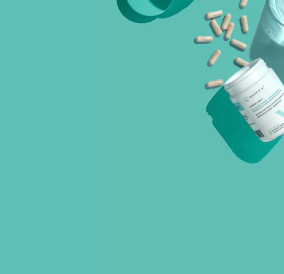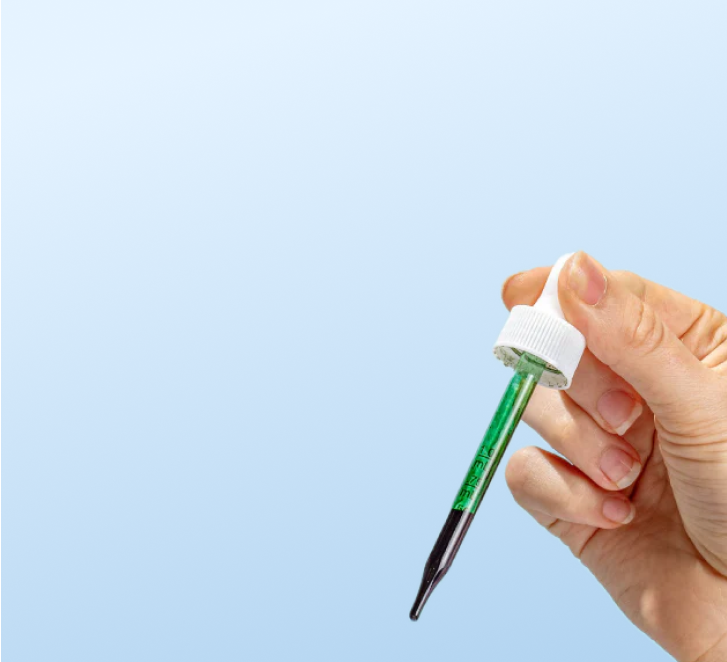- Fact Checked
- October 20, 2025
- 24 min read
What is PMDD: A Comprehensive Guide to Premenstrual Dysphoric Disorder
Table of Contents
Table of Contents
Your period’s on the horizon, and suddenly you’re snapping at people and crying over a commercial. Not all that unusual, right?
But what if your emotions feel unmanageable, your anxiety spikes out of nowhere, and your motivation to even get out of bed completely disappears? This is more than just “really bad PMS.” It could be premenstrual dysphoric disorder (PMDD), a severe and often misunderstood condition that can have a serious impact on a woman’s mental health and overall quality of life.
Let’s talk about what PMDD is, how to know if you have it, and how you can find relief from some of the most severe symptoms.
This post is for informational purposes only and does not constitute medical advice. See full disclaimer below.
What Is PMDD and What Makes It Different from PMS?
Most women of reproductive age are familiar with premenstrual syndrome (PMS), or the bloating, mood swings, and general irritability that can show up in the days before a period1. In fact, around 85% of women experience PMS symptoms at some point in their reproductive years. Symptoms of PMS are mild to moderate and include mild mood changes, fatigue, breast tenderness, or cravings. While these are definitely not desirable, most women find that they don’t interfere with their daily life.
But for 5 to 8% of women, those days before their period bring something far more severe: premenstrual dysphoric disorder (PMDD). PMDD is often mistaken for “really bad PMS,” but it’s actually something completely different. It is a serious medical condition that causes intense mood disturbances like depression, anxiety, rage, or emotional volatility that can disrupt work, relationships, and overall quality of life2.
PMS and PMDD generally happen along the same timelines—appearing a few days before your period and dissipating a few days after your menstrual cycle. But while PMS might make you feel “off,” PMDD can make you feel like a completely different person for one to two weeks every month. The symptoms of PMDD aren’t just inconvenient. For many, they’re completely debilitating.
Common Symptoms of PMDD
Like with PMS, PMDD can look different from person to person. Some people experience intense anxiety or panic attacks, while others experience severe depression or hopelessness. Also like with PMS, the symptoms of PMDD can vary from cycle to cycle.
Physical Symptoms of PMDD
The physical symptoms of PMDD are often very similar to PMS, though they can feel stronger and be harder to find relief from. Physical symptoms of PMDD can include:
- Breast tenderness or swelling
- Joint or muscle pain
- Bloating and weight gain
- Changes in appetite, food cravings, or binge eating
- Sleep disturbances, including insomnia or sleeping too much
- Headaches
- Fatigue and low energy
Emotional and Psychological Symptoms of PMDD
Instead of feeling a bit weepy or irritable, like with PMS, people with PMDD often report more extreme symptoms that can include:
- Severe depression, sadness, feelings of hopelessness, or self-deprecating thoughts
- Intense anxiety, tension, panic attacks, or feeling "on edge," overwhelmed, or tense
- Extreme mood swings and unexplained bouts of crying
- Persistent irritability or anger that may affect other people and lead to conflicts
- Feeling out of control or overwhelmed
- Lack of interest in daily activities and relationships
- Difficulty concentrating or focusing on tasks
- Fatigue or low energy that makes it hard to complete routine activities
In severe cases of PMDD, some women have even reported thoughts of suicide3, which require immediate help either by calling 988 (Suicide & Crisis Lifeline) or going to the nearest emergency room.
Even if you are not having suicidal thoughts, the intensity of the emotional symptoms often makes it difficult to maintain normal routines, attend work or school, or sustain healthy relationships. Many people with PMDD describe feeling like a completely different person, which can be both frightening and demoralizing.
What Causes PMDD?
The exact cause of PMDD isn’t fully understood, but one thing is clear: it isn’t just “being hormonal,” you aren’t “too emotional,” and it’s not “all in your head.”
At its core, PMDD is believed to stem from an abnormal sensitivity to the natural hormonal changes that happen during the menstrual cycle, particularly the shifts in estrogen and progesterone that occur after ovulation.
For most women, these hormone fluctuations come and go with only mild effects. But for those with PMDD, the brain reacts differently. Studies show that people with PMDD have heightened sensitivity in the parts of the brain that regulate mood and stress, especially in how their brain chemicals (like serotonin and GABA) respond to hormonal changes. When estrogen and progesterone levels drop during the luteal phase (aka the two weeks before your period), serotonin levels may dip more dramatically, triggering the severe mood symptoms we just mentioned.
But hormones aren’t the only factor. There are many other factors that can increase your risk or worsen symptoms, and science is still working to understand all the various complexities.
Other risk factors that have been identified include:
Age
PMDD most commonly appears in women in their 20s and 30s, when cycles are regular, hormone fluctuations are strong, and life stressors (think: career, parenting, relationships) are often at their peak.
Postpartum
After childbirth, estrogen and progesterone levels drop dramatically, a change that can trigger PMDD symptoms or make existing ones worse. If you’ve experienced postpartum depression or anxiety, this can also put you at increased risk of PMDD in later cycles.
Perimenopause
Perimenopause, or the years leading up to menopause, is defined by unpredictable hormone fluctuations, particularly in estrogen4. These erratic shifts can mimic or intensify PMDD symptoms, sometimes making the luteal phase feel longer or more volatile. For some women, PMDD symptoms peak during perimenopause before finally resolving after menopause when hormone levels stabilize.
Family history/genetics
PMDD often runs in families5. If your mother or sister has ever experienced PMDD or severe PMS, you are at an increased risk for developing it as well.
Neurochemical differences
People with PMDD may have brains that react more strongly to normal hormone changes, like those that occur before a period, making it harder for them to handle stress, control anxiety, and keep emotions steady in the weeks before a period.
Trauma
Past trauma, which can include childhood adversity, emotional abuse, or sexual assault, can change how the brain handles stress and make your nervous system more reactive. This reactivity can make you not only more sensitive to external triggers and stressors, but internal ones, like hormonal shifts before a period.
Existing mental health conditions
Depression, anxiety, or bipolar disorder don’t cause PMDD. But people with these conditions often report that existing mood symptoms intensify leading up to their period. In some cases, a person can have both depression or anxiety and PMDD, which requires a more nuanced treatment plan.
Thyroid disorders and metabolic issues
Thyroid disorders, adrenal fatigue, or insulin resistance can all disrupt hormonal balance and mimic or compound PMDD symptoms, particularly fatigue and mood swings. This is why screening for these disorders is often a part of PMDD diagnosis.
Lifestyle
While the ways you eat, move, and rest do not cause PMDD directly, they can impact the severity of PMDD symptoms. For example, lack of sleep, poor diet, and chronic stress all worsen hormonal sensitivity and inflammation. When it comes to diet in particular, nutrient deficiencies, especially low magnesium, calcium, or vitamin B6, have also been linked to more severe PMS and PMDD symptoms, and smoking, alcohol, and drug use can disrupt neurotransmitter balance and liver metabolism, which is critical for clearing excess estrogen from the body.
Being overweight
Excess body fat can influence estrogen levels and inflammation, both of which may worsen PMDD symptoms and make hormonal balance harder to maintain. That's because fat cells actively produce estrogen, meaning higher body fat can lead to greater hormonal fluctuation. Chronic inflammation can also disrupt the brain chemicals that help regulate mood, like serotonin and GABA, making PMDD symptoms even worse.
Inflammation and gut health
Emerging research links chronic inflammation and gut microbiome imbalances to mood regulation and hormone metabolism, both of which may influence PMDD symptoms. An imbalanced gut microbiome can slow the breakdown of estrogen, leading to hormonal dominance, and may also impair serotonin production (which, believe it or not, is mostly made in the gut!).
What Doesn’t Cause PMDD
PMDD is not caused by poor attitude, lack of willpower, or emotional instability. It’s not your fault, and it’s not a character flaw. It also isn’t caused by normal PMS, stress alone, or a bad diet (though these things can influence how symptoms show up).
Simply put: you didn’t cause your PMDD. Your brain and body just process hormonal changes differently. Understanding that difference and getting proper diagnosis and support is the key to taking back control of your mental and physical well-being.
Getting a PMDD Diagnosis
There is no single blood test or physical exam that can confirm PMDD. Instead, the process often involves a combination of two things: tracking symptoms over several cycles and ruling out other conditions.
Step 1: Symptom Tracking
Before making a PMDD diagnosis, your gynecologist or healthcare provider will usually ask you to track your symptoms for at least two cycles, if not three. This is because symptoms can vary from cycle to cycle, and tracking over a longer period helps reveal the cyclical pattern that distinguishes PMDD from other mood or hormonal disorders.
To track, you can use a simple journal, an app, a printable symptom diary, or a validated tool like the Daily Record of Severity of Problems (DRSP), but you should be tracking your symptoms every single day, not just before your period and not just when you are feeling unwell. Include things like:
- Date and cycle day. Note when your period starts and ends so your provider can see where symptoms fall in your cycle.
- Emotional changes. Track feelings of depression, anxiety, irritability, anger, hopelessness, or sudden mood swings. Rate their intensity from 1–10.
- Physical symptoms. Include things like bloating, breast tenderness, cramps, headaches, fatigue, or sleep changes.
- Cognitive symptoms. Write down issues with concentration, forgetfulness, or feeling “foggy.”
- Daily impact. Note whether symptoms interfere with work, relationships, or normal activities. For example, “called in sick,” “cried during a meeting,” or “avoided social plans.”
- Relief after menstruation: Record how quickly symptoms improve once your period begins. PMDD symptoms usually disappear within a few days of bleeding.
Menstrual Cycle Tracking
How Do You Track Your Menstrual Cycle And Why Does It Matter for Your Health?
The DSM-5 (aka the standard classification for a variety of mental disorders) states that in order to get a PMDD diagnosis, you must experience at least five symptoms during the week before your period, with at least one being mood-related. These symptoms must substantially interfere with work, school, social activities, or relationships, and they must improve within the week after your period ends.
DSM-5 Diagnostic Criteria for PMDD
| Criteria | Description |
| Timing |
Symptoms occur during the luteal phase (the two weeks before menstruation) and resolve within a few days after bleeding begins. |
|
Symptom Count |
At least five symptoms must be present, including one mood-related symptom such as depression, anxiety, mood swings, or irritability. |
| Impact | Symptoms must cause significant distress or interfere with daily functioning, including work, school, or relationships. |
| Duration | The pattern must be observed for at least two consecutive menstrual cycles. |
| Exclusion |
Symptoms cannot be better explained by another medical or psychiatric condition (such as major depression or generalized anxiety). |
Remember that while it can be uncomfortable to discuss certain aspects of your daily life, like missing work or conflicts with family members, it’s important to be as honest as possible so you can get the most accurate diagnosis.
Step 2: Ruling Out Other Conditions
Because PMDD shares symptoms with several other mental and physical health conditions, your provider will also want to make sure something else isn’t responsible for what you’re feeling. This isn’t to dismiss your experience, but to ensure that you ultimately get the most effective treatment so you can feel better.
To confirm a PMDD diagnosis, your doctor will likely:
- Review your full medical and psychiatric history. This helps identify patterns or past diagnoses that could overlap with PMDD.
- Conduct a physical and pelvic exam. These help rule out gynecologic or hormonal issues that may mimic PMDD, such as thyroid disorders or perimenopause6.
- Order lab tests. Thyroid function tests, hormone panels, or metabolic screenings may be done to exclude conditions that affect mood and energy.
- Assess for mental health conditions. Depression, anxiety, or bipolar disorder can share many symptoms with PMDD, but PMDD is unique in that symptoms appear only during the luteal phase of your menstrual cycle and resolve afterward.
Potential Complications with PMDD
Living with PMDD can take a real toll, mentally, physically, emotionally, and socially. With a proper diagnosis and effective interventions, though, the worst of these complications can be avoided or corrected.
Mental Health Risks
Untreated PMDD can lead to serious mental health consequences. The most concerning is the increased risk of suicidal thoughts or behaviors, including self-harm, especially during the luteal phase when symptoms peak. Severe distress, no matter the cause, deserves urgent care, not silence.
Please Reach Out
Even when suicidal thoughts aren’t present, the monthly cycle of depression and anxiety that comes with PMDD can develop into more persistent mood disorders that extend beyond the premenstrual phase and require ongoing mental health treatment, like general depression, anxiety, or eating disorders.
Coping and Lifestyle Challenges
Many people with PMDD struggle to find healthy ways to cope with the intense emotional swings. This can sometimes lead to unhealthy patterns like emotional eating, bingeing, increased alcohol use, or smoking. These behaviors don’t cause PMDD (they’re often a response to the distress it brings), but they can make symptoms worse over time and affect other areas of physical health.
Relationships Challenges
PMDD often doesn’t just affect you, but the people you interact with most. The irritability, exhaustion, or emotional withdrawal that come with PMDD can strain relationships with partners, friends, and coworkers. Canceled plans or sudden mood shifts can create guilt or misunderstanding, leading many to feel isolated or “hard to be around.” Just remember that these challenges are symptoms of a medical disorder, not a reflection of who you are as a person.
Work and School Challenges
The exhaustion, brain fog, or emotional instability that come with PMDD can make it hard to focus, meet deadlines, or even get out of bed some mornings. Missing work or classes during the luteal phase can quickly add up, leading to performance issues, disciplinary action, or falling behind academically.
These setbacks can feel discouraging, but it’s important to remember that they stem from a medical condition, not a lack of effort or discipline. Being open with a trusted teacher, manager, or HR department about your diagnosis can help you access reasonable accommodations, like flexible deadlines or remote work days, that make it easier to manage symptoms and maintain progress.
Physical Health Impacts
PMDD can also throw off your sleep and circadian rhythm, leading to insomnia, fatigue, or daytime brain fog. All of this can lead to increased inflammation and stress hormones, which in turn can worsen symptoms.
The Good News: PMDD Is Treatable
While PMDD can be deeply disruptive, it’s also highly manageable. With the right support and treatment plan, most people get relief from their symptoms and are able to enjoy life every week of the month (not just those outside their luteal phase).
How PMDD Can Change Over Time
PMDD doesn't stay the same forever. Many women find that it can symptoms can shift with age, stress, or hormonal changes. The most important thing, though, is not to let these shifts deter you from treatment in general because, as you'll see, consistently seeking and adjusting treatment as-needed makes the biggest difference in how PMDD progresses over time.
Without Treatment
When PMDD is left untreated, symptoms often become stronger, more consistent, and more disruptive over time.
What might start as a few bad days of irritability or sadness each month can turn into one or two weeks of debilitating mood swings, anxiety, or fatigue that impacts your relationships and your career. Emotional symptoms and physical symptoms become more intense, and each cycle can feel harder to recover from. For some people, PMDD is something they have no relief from because it develops into a long-term mood disorder, like chronic anxiety or depression, that affects them all month long.
With Treatment
With the right treatment and ongoing support, most people notice meaningful improvement in PMDD within just a few cycles. That means that however you're feeling now, in 2-3 months, you could be feeling a lot better.
That's because PMDD treatment helps:
- Stabilize mood and energy, making the luteal phase feel far more predictable and manageable
- Reduce physical discomfort, like cramps, headaches, and bloating
- Shorten recovery time, so you can bounce back faster after your period starts
- Improve relationships and work-life balance, since emotional regulation and focus become easier
Long story short, for most women with PMDD, treatment is the only reliable path to feeling like themselves again.
Treatment and Management Strategies
Like we said, PMDD is treatable, though treatment looks different from every person and often involves the right combination of medical care, therapy, and lifestyle support. The key is to work with your doctor and to keep trying until you find the right combination that works for you.
An effective PMDD treatment plan often includes a combination of the following:
1. Medication
Because PDD is a disorder that is driven by underlying brain chemistry and hormonal sensitivity, medication is often the first line of treatment . Common prescriptions for people with PMDD include:
- SSRIs (Selective Serotonin Reuptake Inhibitors)7. Antidepressants like fluoxetine (Prozac), sertraline (Zoloft), and escitalopram (Lexapro) are the gold standard for PMDD. They work by stabilizing serotonin levels and can improve both mood and physical symptoms. Unlike with clinical depression, SSRIs often work quickly for PMDD — sometimes even within the first cycle! Depending on your symptoms and health history, your doctor may recommend you take the medication daily throughout the month or just during the two weeks before your period.
- Hormonal birth control. Oral contraceptives that contain drospirenone and ethinyl estradiol are actually FDA-approved for PMDD8. They work by suppressing ovulation and keeping hormone levels steady, which can help prevent the emotional rollercoaster many people experience before their period.
2. Lifestyle Changes
Your daily habits can make a real difference in how severe your PMDD symptoms feel. Small, consistent changes often have the biggest payoff. If you have a PMDD diagnosis, your doctor will likely discuss the importance of key lifestyle choices, including:
- Exercise. Regular movement (even just 30 minutes a day of brisk walking!) can help balance hormones, release mood-boosting endorphins, and reduce anxiety.
- Nutrition. Eat regular, balanced meals with plenty of protein, fiber, and healthy fats. Limit caffeine, sugar, alcohol, and highly processed foods, which can amplify mood swings and fatigue.
- Sleep. Stick to a consistent sleep schedule, even on weekends. Quality sleep helps regulate mood and stress hormones.
- Stress management. Mindfulness, meditation, yoga, or simply getting outside or together with friends can reduce stress and help stabilize mood.
3. Natural and Complementary Approaches
When it comes to medications or natural approaches, it’s not only an either-or situation, especially when it comes to PMDD. Many people find they experience the most relief when they combine SSRIs or hormonal birth control with other complementary approaches like:
Acupuncture and Acupressure
Acupuncture and acupressure have both shown promising results for people struggling with PMS and PMDD9. While research is still limited, several studies suggest they may help:
- Reduce cramps and bloating
- Improve sleep and energy levels
- Ease mood swings and anxiety
- Promote overall relaxation by balancing the body’s stress response
If you’re interested in trying acupuncture, look for a licensed practitioner with experience in women’s hormonal health. If you cannot afford or don’t have access to acupuncture, look into acupressure. This involves applying gentle to specific points and can be done at home.
4. Herbal Remedies
While certain herbs have been used for centuries to relieve premenstrual discomfort, modern research varies in terms of how effective they really are. The most promising herbs from a scientific perspective include:
- Chasteberry (Vitex agnus-castus): One of the most well-researched herbs for PMS and PMDD, chasteberry may help balance hormone levels and reduce irritability, breast tenderness, and mood swings10.
- Chamomile, lavender, or lemon balm tea: While not clinically proven to treat PMDD, these calming herbs may help with relaxation, anxiety, and sleep.
- Ginkgo biloba: Some small studies suggest it may help with bloating and breast tenderness.
Please remember that while herbal remedies can be “natural” they can still interact with certain medications or affect hormone balance. That’s why it’s important to always check with your healthcare provider first.
5. Supplements
There are supplements that can support a healthy diet in helping support mood, hormone balance, and overall well-being in the weeks leading up to your period. But how do you spot which supplements will work and which will waste your money? Look for supplements that clearly list every ingredient on their label (no “proprietary blends”!) and include clinically studied nutrients like:
- Calcium. Research shows calcium can significantly reduce fatigue, cravings, bloating, and mood changes tied to PMS and PMDD11.
- Vitamin B6. It can help regulate serotonin and dopamine levels to promote stable mood and lessen irritability.
- Zinc. There’s evidence that zinc plays a role in hormone regulation and immune function; low zinc levels are linked to more severe PMS symptoms.
- Vitamin D3. Vitamin D3 is important for hormone metabolism and mood regulation, and deficiencies are associated with more intense PMS and PMDD symptoms.
- Folic Acid (Vitamin B9). It supports neurotransmitter production and helps stabilize mood by assisting serotonin synthesis.
Together, these nutrients target the core systems affected by PMDD (think: mood, energy, inflammation, and hormonal regulation), creating a foundation for month-long balance.
Happy V’s PMS Support tincture combines all these science-backed ingredients and more into one simple formula designed to help reduce cramps, stabilize mood, and support hormonal harmony, completely naturally.
6. Therapy and Emotional Support
Since PMDD affects your mood, your mind, and your relationships, therapy is often an important part of PMDD treatment.
Some therapists specialize in women’s mental health or reproductive psychiatry, which can be helpful for navigating PMDD, but many women with PMDD also find benefit from general cognitive behavioral therapy or CBT, which helps them recognize and manage the thought patterns and emotional responses that worsen PMDD symptoms.
CBT for PMDD typically involves:
- 8-16 sessions with a trained therapist
- Learning to recognize negative thought patterns
- Developing coping strategies for managing symptoms
- Behavioral activation to maintain engagement in activities
- Stress management techniques
CBT can be used as a standalone treatment for mild to moderate PMDD or in conjunction with medication like antidepressants for more severe cases, and research shows that CBT in general provides lasting benefits by teaching skills that persist beyond the therapy period.
You can also ask your gynecologist or healthcare provider about PMDD-specific support groups that exist either online or locally, so you can share experiences and get advice from others who “get it”.
7. Symptom Tracking
Symptom tracking shouldn’t stop at diagnosis. Daily notes about your mood, energy, sleep, and physical changes can help you and your provider spot triggers, measure progress, and adjust your treatment plan as needed. Over time, this record becomes one of your most valuable tools for staying in tune with your body.
8. Realistic Expectations
Managing PMDD takes time and patience. Improvement doesn’t always happen overnight. It may take a few cycles to find what works best for you. Celebrate small wins, give yourself grace on tough days, and remember that progress, not perfection, is the goal.
9. Trial-and-Error
Like we said, there’s no one-size-fits-all treatment for PMDD. What works wonders for one person might not help another—and that’s okay. The key is patience and persistence. It can take a few cycles (and sometimes a few adjustments) to find what works best.
If your current plan isn’t working after 2–3 months, talk to your provider about adjusting the dose, trying a different medication, or adding therapy. In some cases, you may be referred to a reproductive psychiatrist or women’s health specialist for more tailored care.
When to Seek Medical Advice
PMDD can be overwhelming, but you don’t have to wait until you’re in crisis to get help.
When to Reach Out for an Evaluation
You don’t need to hit rock bottom to seek care. Reach of to your healthcare provider if you notice symptoms like:
- Severe mood changes or anxiety that make daily life difficult
- Fatigue, bloating, or pain that limits your normal activities
- Existing depression or anxiety that worsens predictably before your period
Еven if you aren’t sure if your symptoms are extreme, it’s still valid (and smart!) to reach out if they’re:
- Persistent, or showing up regularly for several cycles.
- Cyclical, or appearing before your period and easing once it starts.
- Disruptive and interfering with your work, relationships, or daily life.
Before your appointment, track your symptoms for at least two full cycles. Note their intensity, duration, and how they affect your daily life. This documentation helps your provider identify PMDD’s cyclical nature and rule out other causes.
Feeling prepared can also make your appointment more productive and less intimidating. Along with a symptom diary, try bringing these questions to help guide the conversation:
- Could my symptoms be related to PMDD, or is something else contributing?
- What’s the best way to track my symptoms for diagnosis?
- What treatment options do you recommend, and what should I expect from each?
- How long should I give a treatment before deciding if it’s working?
- Are there supplements, lifestyle changes, or therapies that could support my plan?
- Can I be referred to a specialist in PMDD or women’s mental health?
When to Reach Out After Diagnosis
PMDD symptoms can shift over time due to stress, life changes, or hormonal fluctuations, so ongoing communication is essential.
Continue tracking your symptoms and let your provider know if you notice:
- New or worsening mood or physical symptoms
- Side effects from medication or supplements
- Emotional burnout, or feeling like your plan isn’t working anymore
Regular follow-ups allow your provider to fine-tune your treatment plan, whether that means adjusting medication, adding therapy, or trying new supportive approaches.
Reach out between regular appointments if you ever:
- Experience a sudden return or spike in symptoms
- Feel your medication or supplement isn’t working
- Are trouble functioning or staying consistent with daily tasks
And please, please seek immediate help if you ever experience:
- Thoughts of suicide or self-harm (call 988 or text “HELLO” to 741741),
- Feeling out of control or unable to care for yourself
Panic attacks or depressive episodes that feel overwhelming
Final Thoughts
PMDD can make you feel like a stranger in your own body—exhausted, irritable, or emotionally out of control for half the month. But you don’t have to live that way. PMD is real, diagnosable, and treatable with the right combination of medical care, therapy, and holistic support.
If you suspect you have PMDD, start by tracking your symptoms and talking openly with your healthcare provider. Be honest about how it affects your relationships, work, and sense of self — your experience matters.
And remember: progress doesn’t happen overnight, but it does happen. If you are in crisis or having thoughts of suicide, please reach out immediately:
- National Suicide & Crisis Lifeline: Call or text 988
- Crisis Text Line: Text "HELLO" to 741741
- Go to your nearest emergency room
Keep the Conversation Going
- Visit our blog for more on BV treatment options and women's health tips.
- Join our private Happy V Facebook group to hear from others who've been there.
- Explore supplements designed to support your vaginal health journey.
Disclaimer: This blog is for informational and educational purposes only and is not intended to diagnose, treat, cure, or prevent any disease. Statements about supplements have not been evaluated by the Food and Drug Administration. For more information about vaginal infections, visit the CDC or speak to a licensed healthcare provider.












